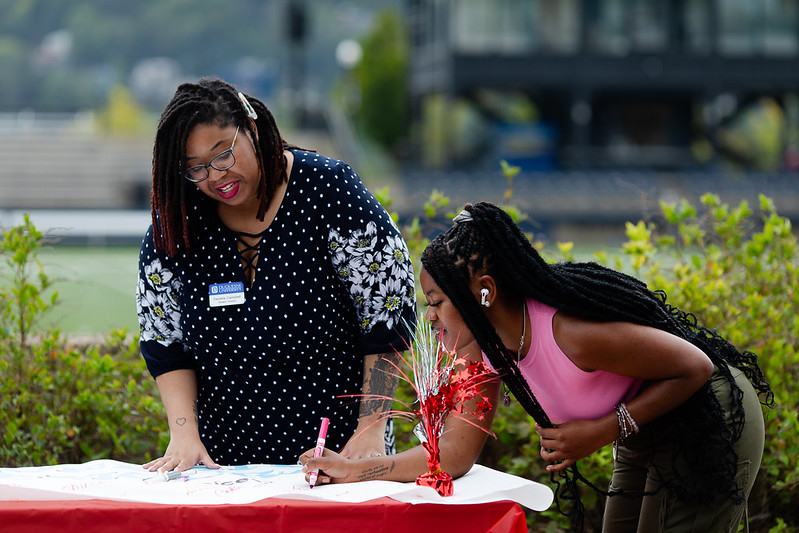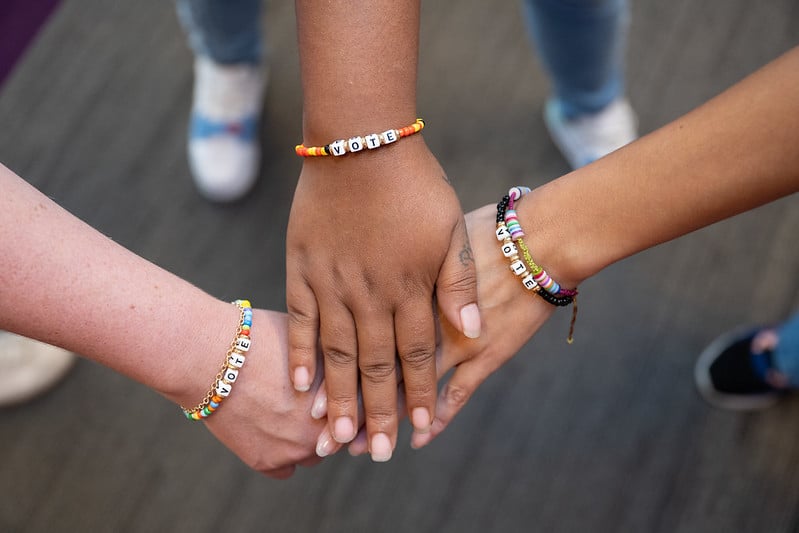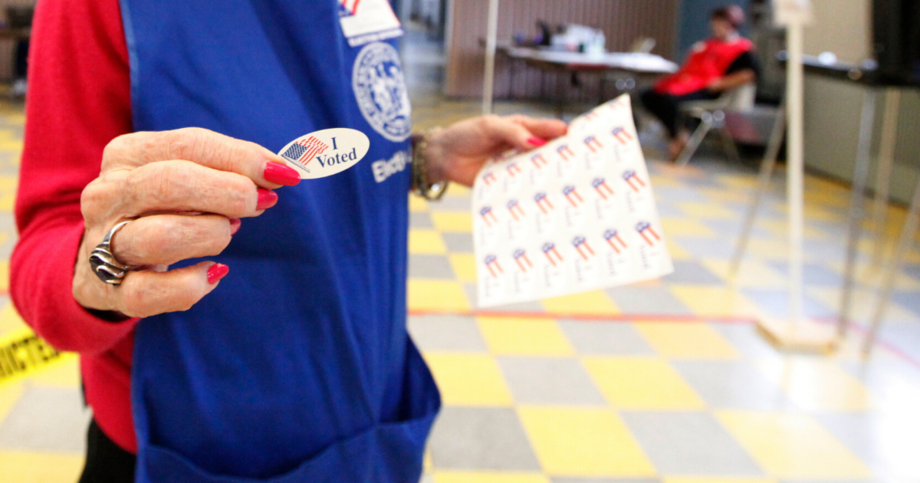With each presidential election, a wave of voters seek out information about the Electoral College to remind themselves how this antiquated, confusing system works. We wrote our own explainer; in short, the Electoral College distorts the democratic promise of “one person, one vote” by awarding electoral votes from each state in support of a candidate instead of simply counting the total number of votes nationwide.
The League of Women Voters of the United States has undertaken a bold and visionary initiative — our One Person One Vote campaign — to fundamentally reshape the way we elect our president by abolishing the electoral college and embracing a truly representative approach to electing the president.
,
,
This oft-tried, yet transformative endeavor seeks to ensure that every vote cast in a presidential election holds equal weight, no matter the state in which it is cast. As part of this, it promotes the National Popular Vote Interstate Compact (NPVIC) as part of the solution towards creating a more representative democracy.
As we confront the challenges posed by the Electoral College and its implications for fair representation, the NPVIC stands as a beacon of hope for a more democratic electoral system, one that aligns with the core principles of equality and voter empowerment.
,

,
What is the Electoral College?
Casting a vote for President works differently from voting for state candidates. When we elect a governor, secretary of state, mayor, or even a coroner, the candidate who earns the most votes wins the election. But when you cast your vote for President of the United States, you aren’t voting directly for a candidate. Instead, you’re technically voting for a slate of “electors” who’re then pledged to support a particular candidate.
In this system, whichever candidate wins the popular vote in a state receives all of that state's electoral votes, regardless of the margin of victory. For example, if Candidate A wins 51% of the popular vote in a state, they receive all of that state's electoral votes, while Candidate B receives no electoral votes, even though nearly half of the voters supported Candidate B. This system undermines the principle of democracy, as it can allow a candidate who does not have majority support among voters to still secure victory through the electoral college.
,
,
Each state receives at least three electors, one per representative and two for their senators. The District of Columbia isn’t a state but was given three electoral votes after the passage of the Twenty-Third Amendment, which brings the College to its current total of 538 electors. These electors then formally elect the President and Vice President based on the outcome of the votes in their respective states.
The one exception is Nebraska, which apportions its electors based on a congressional district rather than the “winner-takes-all" system. Partisan-driven actors are leading a strong push in Nebraska to adopt a winner-take-all system ahead of the 2024 election. While nothing has been signed into law or passed by the legislature at the time of this publication, the pressure to adopt the system is mounting.
,

,
The winner-take-all system can discourage voter turnout and engagement, particularly in states where one party consistently dominates the elections. In these "safe" states, where the outcome is largely predetermined, voters who support the minority party may feel their votes are effectively wasted, leading to apathy and disenfranchisement.
A more comprehensive breakdown of how it works can be found here. While this system has plenty of issues on its face, the history behind and reasons it was adopted are even more troubling.
The Racist History of the Electoral College
The Electoral College has not existed since our nation’s founding. It was established in 1877 in response to the highly disputed presidential election between Rutherford B. Hayes and Samuel J. Tilden. Tilden won the popular vote in the election, but the electoral votes in several key states were contested when Congress met to finalize the results.
,
,
The election ultimately hinged on three Southern states, each with competing electoral returns. Congress lacked procedures to resolve the dispute, forming an ad hoc Electoral Commission of senators, representatives, and Supreme Court justices. This led to the passage of the Electoral Count Act, which resulted in the Electoral College.
Notably, this decision and the College are rooted in (and continue to perpetuate) systemic racism. For example, the system was established to depend on the “three-fifths compromise,” a provision in the US Constitution that counted enslaved people as three-fifths of a person. Legislators knew that because of the compromise, states with enslaved people would have greater representation in Congress and, therefore, more electors in the Electoral College. This despite the fact that those enslaved people could not cast their own votes.
In summary, the “compromise” bolstered the political power of Southern states without granting actual representation or voting rights to these people.
,
Launch video for One Person One Vote campaign
,
The Electoral College’s racist origins and its interaction with other discriminatory practices in the electoral system have contributed to racial inequities in American democracy, enabling certain people’s votes to count more or less than others. Even today, it overrepresents certain states and underrepresents others. These inequities underscore the need for electoral reforms prioritizing fairness, equity, and the full participation of all citizens in the democratic process.
One Solution: The National Popular Vote Interstate Compact
The National Popular Vote Interstate Compact (NPVIC) is a groundbreaking initiative to reform how the United States conducts presidential elections.
In essence, the NPVIC proposes an agreement among participating states to award all of their electoral votes to the presidential candidate who wins the national popular vote rather than the candidate who wins the popular vote within each state. This means the candidate who receives the most votes nationwide would be guaranteed to win the presidency once enough states representing a majority (270 electoral votes) join the compact.
,
Support our work for a fairer, more representative electoral system!
,
The need for the NPVIC arises from several shortcomings in the current electoral system, most notably the winner-take-all system and the disproportionate influence of swing states. Swing states, where the election outcome is uncertain and the margins are very thin between support for the two parties, usually receive disproportionate attention from candidates. Additionally, swing states often dictate the election outcome, leaving voters' voices in non-swing states marginalized. By implementing the NPVIC, states can ensure that every vote counts equally and that the candidate who receives the most votes nationwide ultimately wins the presidency, reflecting the will of most American voters.
Rather than promoting the winner-takes-all system, the NPVIC prioritizes the national popular vote winner. In doing so, NPVIC aims to make every vote equal.
Conversations about implementing this plan came ahead of the 2008 presidential election. Maryland was the first state to join the NPVIC on April 10, 2007. They were followed by New Jersey, Illinois, Hawaii, and Washington state in 2008. In April 2024, Maine became the most recent state to join the NPVIC. Currently, 16 states and Washington, DC have joined the compact: Connecticut, Rhode Island, Vermont, Hawaii, Maine, Massachusetts, Maryland, Washington, New Jersey, Illinois, New York, California, Colorado, New Mexico, Delaware and Oregon. Together, these states account for 196 of the 270 electoral votes needed for the NPVIC to be implemented.
,

,
Additionally, bills adopting the NPVIC have at least partially advanced in states where it is not fully adopted, like Arkansas, where it has passed the House twice, reflecting ongoing support for this reform. The NPVIC will take effect when enacted by states possessing an additional 61 electoral votes.
How is the League Working to Abolish the Electoral College?
In the ongoing pursuit of a more equitable and representative electoral system, the League of Women Voters has maintained a steadfast commitment to advocating for the direct election of the President by popular vote. This advocacy traces back to a study conducted in 1970, which culminated in the League's endorsement of direct election as essential to true representative government.
Since then, the League has been at the forefront of efforts to abolish the Electoral College and replace it with a direct election system. Throughout the years, LWVUS has testified before Congress, lobbied for legislative reforms, and consistently championed the cause of electoral fairness. In 1997, the League reiterated its call to abolish the Electoral College in testimony before the House Subcommittee on the Constitution.
,
,
In a nod to innovative approaches to electoral reform, the League embarked on a study of the National Popular Vote proposal in 2008. This proposal garnered the support of League delegates in 2010 as a viable interim solution until the abolition of the Electoral College can be achieved. Since then, many states have adopted the NPVIC and the League has been involved in the efforts to make it happen. These efforts led to our One Person One Vote campaign, which launched in spring 2024.
Since its inception, the League has been a tireless advocate for electoral reform, rooted in its commitment to representative government and voter empowerment. The need for reform is underscored by the Electoral College's fraught history, which is intertwined with systemic racism and disenfranchisement. LWV is proud to support initiatives like the National Popular Vote Interstate Compact. Through its commitment to badly needed electoral reform and its support for creative solutions like the NPVIC, the League of Women Voters continues to drive the movement toward a more democratic and representative electoral system. As more states join the compact and momentum builds for change, the vision of a truly equitable and inclusive electoral process draws ever closer to realization.
,

,
How You Can Work to Abolish the Electoral College
There are numerous ways you can join us in advocating for electoral reform today:
- Contact your state legislators to express your support for adopting the National Popular Vote Interstate Compact (NPVIC) in your state;
- Sign up for our One Person One Vote email list to stay up to date on the news around the Electoral College;
- Engage with your local League of Women Voters to learn more about how you can contribute to electoral reform efforts;
- Join our digital organizing app, League in Action, to get regular updates about actions you can take to promote a fair democracy.
Let's advocate for broader reforms that enhance voter participation and ensure fair representation. Your voice and involvement can make a difference in shaping a more equitable electoral system.